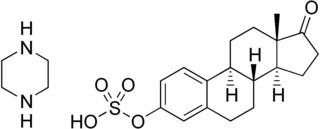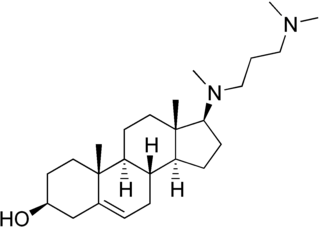Nialamide is a non-selective, irreversible monoamine oxidase inhibitor (MAOI) of the hydrazine class that was used as an antidepressant. It was withdrawn by Pfizer several decades ago due to the risk of hepatotoxicity.

Estropipate, also known as piperazine estrone sulfate and sold under the brand names Harmogen, Improvera, Ogen, Ortho-Est, and Sulestrex among others, is an estrogen medication which is used mainly in menopausal hormone therapy in the treatment of menopausal symptoms. It is a salt of estrone sulfate and piperazine, and is transformed into estrone and estradiol in the body. It is taken by mouth.

Etoperidone, associated with several brand names, is an atypical antidepressant which was developed in the 1970s and either is no longer marketed or was never marketed. It is a phenylpiperazine related to trazodone and nefazodone in chemical structure and is a serotonin antagonist and reuptake inhibitor (SARI) similarly to them.

Etynodiol diacetate, or ethynodiol diacetate, sold under the brand names Demulen and Femulen among others, is a progestin medication which is used in birth control pills. The medication is available only in combination with an estrogen. It is taken by mouth.

Cloperastine (INN) or cloperastin, in the forms of cloperastine hydrochloride (JAN) and cloperastine fendizoate, is an antitussive and antihistamine that is marketed as a cough suppressant in Japan, Hong Kong, and in some European countries. It was first introduced in 1972 in Japan, and then in Italy in 1981.

Hydroxydione, as hydroxydione sodium succinate, also known as 21-Hydroxy-5β-pregnane-3,20-dione, is a neuroactive steroid which was formerly used as a general anesthetic, but was discontinued due to incidence of thrombophlebitis in patients. It was introduced in 1957, and was the first neuroactive steroid general anesthetic to be introduced for clinical use, an event which was shortly preceded by the observation in 1954 of the sedative properties of progesterone in mice.

Chlorproethazine, sold under the brand name Neuriplege, is a drug of the phenothiazine group described as a muscle relaxant or tranquilizer which is or has been marketed in Europe as a topical cream for the treatment of muscle pain. It has been associated with photoallergic contact dermatitis.

Azacosterol (INN), or azacosterol hydrochloride (USAN), also known as 20,25-diazacholesterol, is a cholesterol-lowering drug (hypocholesteremic), which was marketed previously, but has since been discontinued. It is also an avian chemosterilant used to control pest pigeon populations via inducing sterility. The drug is a sterol and derivative of cholesterol in which two carbon atoms have been replaced with nitrogen atoms.

Chloral betaine, also known as cloral betaine (INN), is a sedative-hypnotic drug. It was introduced by Mead Johnson in the United States in 1963. It is a betaine complex with chloral hydrate, which acts as an extended-acting formulation of chloral hydrate which is then metabolized into trichloroethanol, which is responsible for most or all of its effects.

Cinnamedrine, also known as N-cinnamylephedrine, is a sympathomimetic drug with similar effects relative to those of ephedrine. It also has some local anesthetic activity. Cinnamedrine was previously used, in combination with analgesics, as an antispasmodic to treat dysmenorrhea in the over-the-counter drug Midol in the 1980s. There is a case report of the drug being abused as a psychostimulant.

Penmesterol (INN), or penmestrol, also known as 17α-methyltestosterone 3-cyclopentyl enol ether, is a synthetic, orally active anabolic-androgenic steroid (AAS) that was developed in the early 1960s. It is the 3-cyclopentyl enol ether of methyltestosterone.

Alentemol (INN), or alentamol, is a selective dopamine autoreceptor agonist described as an antipsychotic, which was never marketed.
Penicillium olsonii is an anamorph, filamentous species in the genus Penicillium which produces several polygalacturonases, xanthoepocin, asperphenamate, verrucolone, phthalate and olnacin. Penicillium olsonii is an often source of spoilage of tomatoes, salami and beans This species occurs ubiquitously in soil
Penicillium thymicola is a halotolerant species of fungus in the genus Penicillium which produces okaramine A, daldinin D, alantrypinone, seranttrypinone, fumiquinazoline F and fumiquinazoline G.
Streptomyces alanosinicus is a bacterium species from the genus of Streptomyces which was isolated from soil in Brazil. Streptomyces alanosinicus produces the antibiotics alanosine and spicamycin.
Streptomyces bluensis is a bacterium species from the genus of Streptomyces which produces bluensomycin.
Streptomyces fumanus is a bacterium species from the genus of Streptomyces which has been isolated from alluvial soil. Streptomyces fumanus produces dioxapyrrolomycin, pyrrolomycin G, pyrrolomycin H, pyrrolomycin I, pyrrolomycin J and fumaquinone.

Anagestone acetate, sold under the brand names Anatropin and Neo-Novum, is a progestin medication which was withdrawn from medical use.
Streptomyces wedmorensis is a bacterium species from the genus of Streptomyces which has been isolated from soil in Pennsylvania in the United States. Streptomyces wedmorensis produces (S)-2-hydroxypropylphosphonic acid epoxidase, fosfomycin and phosphonomycin B.

Amadinone (INN), also known as 19-norchlormadinone, is a steroidal progestin of the 19-norprogesterone and 17α-hydroxyprogesterone groups that was synthesized and characterized in 1968 but was never marketed. It has antigonadotropic properties, and for this reason, is a functional antiandrogen. An acetate ester, amadinone acetate, also exists, but similarly was never marketed.












